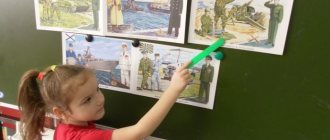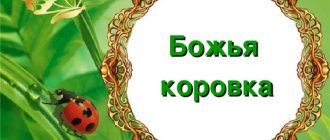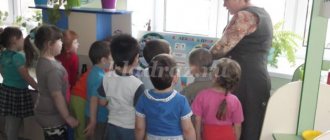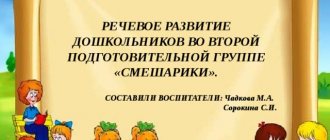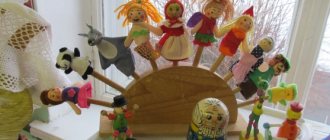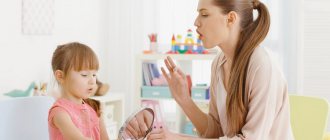Methodological piggy bank for projects
So, dear friends, let's get acquainted with the literature before moving on to a variety of topics.
Together we will look through the pages on the website www.kniga.ru and find a lot of interesting things for our project. An interesting methodological program awaits you. Books, games, projects for preschoolers can be found here.
Another no less interesting site is www.uchmag.ru, where you will find the organization of project activities for children, which is the main requirement for the Federal State Educational Standard. It ensures interaction between parents and teachers in raising children. The program can be installed via the Internet.
On the most interesting website UchMag from the series “To help preschool teachers” you can purchase project notes and organization of design for preschoolers.
Didactic, plot-based, outdoor games are aimed at the personal formation of the child and the development of his creative, mental and social processes. By visiting the methodological site, you, teachers, educators and parents will find comprehensive thematic projects that present entertaining and interesting games with sayings, riddles, stories and poems.
How to conduct short-term projects in the junior group of a preschool educational institution on the topic “Folklore”?
The theme of folklore is a wide field for imagination when planning a project in a preschool educational institution. Children enjoy learning jokes, nursery rhymes, and folk songs. But the peculiarity of holding such events in kindergarten is the synthesis of music and movement. Staging, theatricalization, play - these are the keys that can open the door to a child’s heart.
We offer the following short-term project in the 2nd junior group: “Folklore for children: spring motives.” Here you can give children and parents the task of preparing mini-performances for the Spring or Maslenitsa holiday. To complete this task, preliminary work will be required to familiarize yourself with the traditions of our people, symbols, and the choice of spring flies or Maslenitsa songs, and the preparation of costumes, props, and music. The main thing is that children are assigned tasks that they will need to complete independently. Adults need to emphasize the importance of the role assigned to the child and the significance of the work he has done for the project.
Game projects
Topics on hygiene skills in children
We got acquainted with the literature, now I propose to consider interesting topics. The preschool organization is characterized by interesting and research work in the profession of educators and teachers.
Dear educators and parents, you, of course, want your kids to grow up neat, smart, kind, sympathetic, and you also want to develop cultural and hygienic skills in your kids, don’t you? First, I will propose two projects: the theme of little tidies and the theme of clean hands. The implementation time for the first gaming project is 2-3 weeks, and the second educational, gaming and short-term project is 1 week. Their tasks are:
* proper use of soap;
* careful washing of hands and face;
* wiping dry with a towel after washing;
* use of a comb and handkerchief;
* learning to follow appearance;
* formation of basic table behavior skills: correct use of a spoon, use of a napkin, chewing food with a closed mouth, silence at the table.
First explain all this to the children when playing with dolls: teach them to wipe their mouths, wash the doll’s face and hands, and take care of its clothes. As a result of this project, children themselves will learn to eat carefully, hold a spoon and use a napkin correctly.
This project will also help them dry their face, hands with their towel and then hang it in their place. Children will begin to use handkerchiefs correctly. Personal hygiene will become a natural thing for them. Or you can go on a sea voyage and learn a lot of interesting things.
Bright holiday Easter
The relevance of impressions received in childhood will remain in the memory for a long time. Therefore, it is necessary to introduce children to the history of our Motherland, its culture and its holidays from early childhood. Therefore, the project for the bright holiday of Easter will be a great theme for kids. The purpose of this project is to familiarize children with the Easter holiday, with rituals, customs and its history. It is an informational and creative short-term project and lasts 2 weeks. At the first preparatory stage, the following are compiled:
- long-term action plan;
- recommendations for introducing children to Orthodox culture;
- materials for classes, conversations, illustrations;
- questions with parents related to the topic.
At the second stage, practical classes are conducted:
- with cognitive development: computer presentations “Ryaba Hen”, “Easter Kolobok”;
- with didactic games;
- fiction: Easter stories, conversations;
- artistic creativity: modeling, drawing;
- music with bells, Easter music from a box.
At the third and final stage, exhibitions of interesting crafts by children and parents are organized, as well as participation in a district competition on this topic, as well as work with parents and children’s creativity with them, for example, making Easter eggs.
Project "Poteshki"
The formation and development of children’s speech plays an important role in the child’s personal formation. Nursery rhymes play an important role in the development of children. By listening to simple rhymes, repeated words, exclamations and emotional appeals, children learn to listen and repeat words.
Sound combinations that are repeated create a musical effect with the help of which the pronunciation of sounds and speech hearing of babies develops. Therefore, the Nursery rhymes project will be very useful for young children. It is long-term (1st junior – 2nd junior group)/
The goals of this project are:
- creating positive emotions;
- development of children's speech skills, as well as imagination, thinking and memory.
The objectives are:
- teaching children to listen to short nursery rhymes;
- repetition of words and phrases after the teacher;
- development of monologue and dialogue in children;
- development of fine motor skills in children;
- education of speech culture of sound.
Methods and techniques for implementation are:
- reading nursery rhymes with demonstration of paintings;
- conversations on the meaning of nursery rhymes;
- playing out the plot of nursery rhymes.
As a result, with the targeted and systematic use of nursery rhymes, children master their native language, modeling, drawing, physical and musical development, as well as initial hygiene and self-care skills.
Environmental education of children
Equally important is the upbringing of children related to the protection of the environment. Currently, a loving and caring attitude towards nature is very important for every person. Therefore, it is necessary to introduce children to it from a young age. I hope you agree with me, dear readers.
Therefore, for better implementation of the tasks of environmental activities, project activities on this topic are carried out.
So, let’s start working with the children on the topic: “Let’s feed the birds.” An interesting topic that will foster a caring attitude towards living nature. This is an informational and creative game short-term project for two weeks. The objectives of this project are:
- introducing children to birds;
- learning to answer questions in a short sentence;
- enriching vocabulary on the topic;
- fostering a caring attitude towards birds.
The project can be implemented using:
- jointly writing a story about feeding the birds;
- outdoor game: “Car and sparrows”;
- bird watching;
- memorizing a poem about a bird;
- unconventional drawing technique;
- didactic games, for example “Who lives in the house”;
- working with parents: making feeders.
As a result, children will become acquainted with birds, distinguish them, and learn to imitate bird voices. Children will develop compassion, responsiveness, and goodwill.
You can also introduce children to the project “Objects of Inanimate Nature” and develop children’s knowledge about the physical properties of the external environment, introduce them to viscosity, flowability, buoyancy, solubility of substances, as well as the sun, air, earth, water as environmental factors. This project will last two weeks.
Junior group. Early childhood, nursery. Children 1-4 years old
Project on environmental education of preschool children “Our Trees” (second junior group) Introduction Environmental education is one of the main directions in the education system; it is a way of influencing children’s feelings, their consciousness, views and ideas. Children feel the need to communicate with nature. They learn to love nature, observe, empathize, understand,...
Children's project in an early age group “Soap is foaming, look!” “Development of a child’s cognitive activity in experimental research activities with objects of living and inanimate nature. Children's project in an early age group “Soap is foaming, look!”
Slide 2 - relevance The child is inquisitive. Tends to observe and experiment. Working...
Other events
There are also other informational and creative game projects, such as “Cat”, the purpose of which is to familiarize yourself with a domestic animal, in this case a cat, with its characteristics, habits, appearance, as well as fostering a caring attitude towards animals.
It will be interesting to show children the game project “Cat House” on video:
Another information and creative project is “Vitamins”. This topic studies the issues of maintaining health in children. Here ideas are given about vitamins, their importance for health, and proper nutrition. This project lasts 3 weeks.
“My Family” is the name of a creative long-term project. Its purpose is to provide an initial introduction to the family. The objectives are to evoke positive emotions about the family, develop expressions of tenderness, joy, and cultivate respect for parents. I suggest watching a video on this topic with your little friends:
Since preschoolers love to explore everything and put it into practice, there is such an educational, research, group event “The Magic Drop”, the purpose of which is to consolidate existing knowledge about water. The objectives are to familiarize children with the properties of water, support children’s initiative, ingenuity and encourage friendships during the period of research. The project lasts 2 weeks. It's short-term.
Also interesting is the event, the work plan for the master class, which offers creative tasks for parents, organizing competitions, participating in project activities, aimed at developing the children’s abilities and promoting trusting relationships between the family and the kindergarten.
So, to summarize, I come to the conclusion that interesting topics in kindergartens will help develop the intellectual and physical development of children. Therefore, together, dear teachers, educators, and parents, let us make every effort to ensure that our children grow up healthy.
I hope that with this article I helped you make action plans in kindergartens and other preschool institutions. I say goodbye to you, but not for long. Stay tuned for other interesting and informative articles. And if you have questions, be sure to ask. I will be happy to answer them. Share this article with your friends, and by subscribing to my blog updates, you will learn a lot of interesting things.
Sincerely, Tatyana Sukhikh! Till tomorrow!
By the way, I recommend reading:
Short-term projects in visual arts
Drawing is always a joy for children. And if this activity is also organized purposefully, the result will exceed all the kids’ expectations! Their activities will not only be interesting for themselves, but also useful for others!
How to conduct a short-term project in the 2nd junior group in fine arts? For example, as part of the “Spring Drops” theme, you can invite kids to decorate a group room in a kindergarten with collective or individual artwork. So, the teacher first introduces children to primroses by observation. Then he offers to color the finished flower images using various drawing techniques. In this way, you can create a whole “spring flowerbed” in the room.
